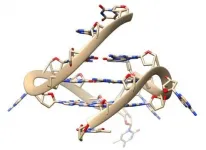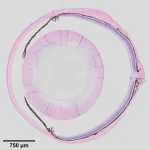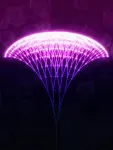(Press-News.org) New probes allow scientists to see four-stranded DNA interacting with molecules inside living human cells, unravelling its role in cellular processes.
DNA usually forms the classic double helix shape of two strands wound around each other. While DNA can form some more exotic shapes in test tubes, few are seen in real living cells.
However, four-stranded DNA, known as G-quadruplex, has recently been seen forming naturally in human cells. Now, in new research published today in Nature Communications, a team led by Imperial College London scientists have created new probes that can see how G-quadruplexes are interacting with other molecules inside living cells.
G-quadruplexes are found in higher concentrations in cancer cells, so are thought to play a role in the disease. The probes reveal how G-quadruplexes are 'unwound' by certain proteins, and can also help identify molecules that bind to G-quadruplexes, leading to potential new drug targets that can disrupt their activity.
One of the lead authors, Ben Lewis, from the Department of Chemistry at Imperial, said: "A different DNA shape will have an enormous impact on all processes involving it - such as reading, copying, or expressing genetic information. Evidence has been mounting that G-quadruplexes play an important role in a wide variety of processes vital for life, and in a range of diseases, but the missing link has been imaging this structure directly in living cells."
G-quadruplexes are rare inside cells, meaning standard techniques for detecting such molecules have difficulty detecting them specifically. Ben Lewis describes the problem as "like finding a needle in a haystack, but the needle is also made of hay".
To solve the problem, researchers from the Vilar and Kuimova groups in the Department of Chemistry at Imperial teamed up with the Vannier group from the Medical Research Council's London Institute of Medical Sciences.
They used a chemical probe called DAOTA-M2, which fluoresces (lights up) in the presence of G-quadruplexes, but instead of monitoring the brightness of fluorescence, they monitored how long this fluorescence lasts. This signal does not depend on the concentration of the probe or of G-quadruplexes, meaning it can be used to unequivocally visualise these rare molecules.
Dr Marina Kuimova, from the Department of Chemistry at Imperial, said: "By applying this more sophisticated approach we can remove the difficulties which have prevented the development of reliable probes for this DNA structure."
The team used their probes to study the interaction of G-quadruplexes with two helicase proteins - molecules that 'unwind' DNA structures. They showed that if these helicase proteins were removed, more G-quadruplexes were present, showing that the helicases play a role in unwinding and thus breaking down G-quadruplexes.
Dr Jean-Baptiste Vannier, from the MRC London Institute of Medical Sciences and the Institute of Clinical Sciences at Imperial, said: "In the past we have had to rely on looking at indirect signs of the effect of these helicases, but now we take a look at them directly inside live cells."
They also examined the ability of other molecules to interact with G-quadruplexes in living cells. If a molecule introduced to a cell binds to this DNA structure, it will displace the DAOTA-M2 probe and reduce its lifetime; how long the fluorescence lasts.
This allows interactions to be studied inside the nucleus of living cells, and for more molecules, such as those which are not fluorescent and can't be seen under the microscope, to be better understood. Professor Ramon Vilar, from the Department of Chemistry at Imperial, explained: "Many researchers have been interested in the potential of G-quadruplex binding molecules as potential drugs for diseases such as cancers. Our method will help to progress our understanding of these potential new drugs."
Peter Summers, another lead author from the Department of Chemistry at Imperial, said: "This project has been a fantastic opportunity to work at the intersection of chemistry, biology and physics. It would not have been possible without the expertise and close working relationship of all three research groups."
The three groups intend to continue working together to improve the properties of their probe and to explore new biological problems and shine further light on the roles G-quadruplexes play inside our living cells. The research was funded by Imperial's Excellence Fund for Frontier Research.
INFORMATION:
On April 15, 2020, a brief burst of high-energy light swept through the solar system, triggering instruments on several NASA and European spacecraft. Now, multiple international science teams conclude that the blast came from a supermagnetized stellar remnant known as a magnetar located in a neighboring galaxy.
This finding confirms long-held suspicions that some gamma-ray bursts (GRBs) - cosmic eruptions detected in the sky almost daily - are in fact powerful flares from magnetars relatively close to home.
"This has always been regarded as a possibility, and several GRBs observed since 2005 have provided tantalizing evidence," said Kevin Hurley, a Senior Space Fellow with the Space Sciences Laboratory at the University of California, Berkeley, ...
While most children need to show immunization records to attend school, the same may not be true for camps, a new study suggests.
Nearly half of summer camps surveyed by researchers didn't have official policies requiring campers be vaccinated, according to findings led by Michigan Medicine C.S. Mott Children's Hospital in END ...
KANSAS CITY, MO--What if the degenerative eye conditions that lead to glaucoma, corneal dystrophy, and cataracts could be detected and treated before vision is impaired? Recent findings from the lab of Investigator Ting Xie, PhD, at the Stowers Institute for Medical Research point to the ciliary body as a key to unlocking this possibility.
Previous work from the lab showed that when mouse stem cells were differentiated into light-sensing photoreceptor cells in vitro, and then transplanted back into mice with a degenerative condition of the retina, they could partially restore vision. However, the transplanted photoreceptors only lasted three to four months.
"You cannot cure the condition in a diseased eye if you don't know what ...
Scientists in China and Sweden have determined that a pinch of capsaicin, the chemical compound that gives chili peppers their spicy sting, may be a secret ingredient for more stable and efficient perovskite solar cells. The research, published January 13 in the journal Joule, determined that sprinkling capsaicin into the precursor of methylammonium lead triiodide (MAPbI3) perovskite during the manufacturing process led to a greater abundance of electrons (instead of empty placeholders) to conduct current at the semiconductor's surface. The addition resulted in polycrystalline MAPbI3 solar cells with the most efficient charge transport to date.
"In the future, green and sustainable forest-based biomaterial ...
NEW YORK, January 13, 2021 -- Many animal and insect species use Batesian mimicry -- mimicking a poisonous species -- as a defense against predators. The common palmfly Elymnias hypermnestra -- a species of satyrine butterfly that is found throughout wide areas of tropical and subtropical Asia -- adds a twist to this evolutionary strategy. The females evolved two distinct forms, either orange or dark brown, imitating two separate poisonous model species, Danaus or Euploea. The males are uniformly brown. A population group is either entirely brown (both males and females) or mixed (brown males and orange females).
David Lohman, ...
The iconic, prehistoric dire wolf, which prowled through Los Angeles and elsewhere in the Americas over 11 millennia ago, was a distinct species from the slightly smaller gray wolf, an international team of scientists reports today in the journal Nature.
The study, which puts to bed a mystery that biologists have pondered for more than 100 years, was led by researchers from UCLA, along with colleagues from Durham University in the U.K., Australia's Adelaide University and Germany's Ludwig Maximilian University.
"The terrifying dire wolf, a legendary symbol of Los Angeles and the La Brea Tar Pits, has earned its place among the many large, unique species that went extinct at the end of the Pleistocene ...
Mutations that occur in certain DNA regions, called tandem repeats, may play a significant role in autism spectrum disorders, according to research led by Melissa Gymrek, assistant professor in the UC San Diego Department of Computer Science and Engineering and School of Medicine. The study, which was published in Nature on Jan. 14, was co-authored by UCLA professor of human genetics Kirk Lohmueller and highlights the contributions these understudied mutations can make to disease.
"Few researchers really study these repetitive regions because they're generally non-coding--they do not make proteins; their function is ...
Extinct dire wolves split off from other wolves nearly six million years ago and were only a distant relative of today's wolves, according to new research published in Nature today (13 January).
Dire wolves, made famous in the TV show Game of Thrones, were common across North America until around 13,000 years ago, after which they went extinct.
The study shows that dire wolves were so different from other canine species like coyotes and grey wolves that they were not able to breed with each other. Previous analyses, based on morphology alone, had led scientists to believe that dire wolves were closely related to grey wolves.
The research was led by Durham University in the UK alongside scientists at the University of Oxford, Ludwig Maximilian University in ...
New York, NY--January 13, 2021--Researchers at Columbia Engineering report today that they have developed the first nanomaterial that demonstrates "photon avalanching," a process that is unrivaled in its combination of extreme nonlinear optical behavior and efficiency. The realization of photon avalanching in nanoparticle form opens up a host of sought-after applications, from real-time super-resolution optical microscopy, precise temperature and environmental sensing, and infrared light detection, to optical analog-to-digital conversion and quantum sensing.
"Nobody has seen avalanching behavior like this in nanomaterials before," said James Schuck, associate professor of mechanical engineering, who led the study published today by Nature. "We ...
Even computers can miscalculate. Already small disturbances change stored information and corrupt results. That is why computers use methods to continuously correct such errors. In quantum computers, the vulnerability to errors can be reduced by storing quantum information in more than a single quantum particle. These logical quantum bits are less sensitive to errors. In recent years, theorists have developed many different error correction codes and optimized them for different tasks. "The most promising codes in quantum error correction are those defined on a two-dimensional lattice," ...






